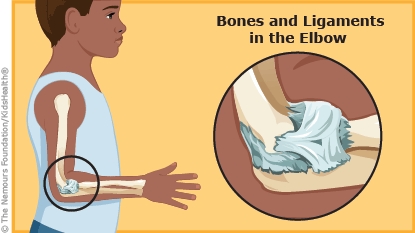Little League elbow is caused by swelling and irritation of a growth plate in the elbow from repeated throwing. The growth plate is a layer of cartilage near the end of a bone where most of the bone's growth happens. It's called "Little League elbow" because it most often affects young baseball or softball pitchers, but it also can happen in other kids who throw a lot.
With rest, Little League elbow usually goes away within a few months and doesn't cause lasting problems. But if your child throws too soon, it can cause permanent elbow damage.

Activity
- Your child needs to stop throwing for 4–6 weeks to let the elbow heal.
- They can do activities that don't use the elbow (like running, soccer, or dancing) to stay active.
- Follow your health care provider's recommendations for when your child can return to pitching and throwing. This usually is when your child:
- does not have any elbow pain (both at rest and during activity)
- has full strength in their arm
- can bend and straighten their elbow fully
- If your child is a pitcher: Work with your health care provider, physical therapist, and coach to make a return-to-pitching program. The program should:
- Slowly increase the number, intensity, and distance of pitches over 6–8 weeks.
- Limit the number of pitches that can be thrown in total per day.
- Set limits for throwing distances.
- Make sure your child is using proper form when pitching.
- If your child isn't a pitcher: Work with your health care provider, physical therapist, and coach to determine what's safe for your child. This may include changing to a playing position with less throwing and making sure they use proper throwing form.
To help with pain and swelling:
- Give your child acetaminophen (Tylenol® or a store brand), ibuprofen (Advil®, Motrin®, or a store brand), OR naproxen (Aleve®, Naprosyn®, or a store brand) as needed for pain. Follow the directions on the label for how much to give and how often.
- Place ice wrapped in a towel on the elbow for about 20 minutes several times a day. Do not put ice directly on the skin.
- If your health care provider recommends it, wrap the elbow in an elastic bandage.
Follow your health care provider's advice for:
- Any movement exercises or stretches your child should do and any activities to avoid.
- Taking your child to a bone doctor (orthopedist), sports medicine doctor, or physical therapist to help them build strength and flexibility and create a plan for returning to full activities and sports.
- When your child should follow up.

Your child has elbow pain:
- that doesn't get better after following your health care provider's instructions
- that goes away and then comes back

What causes Little League elbow? Little League elbow usually happens during the growth spurt of puberty (around 8–15 years old) when bones, muscles, and tendons (bands of connective tissue that connect muscles to bones) grow at different rates. The tendons can get tight, and in kids who throw a lot, they pull on and injure the growth plate of the elbow.
What can help prevent Little League elbow? Young athletes should:
- Take a break from throwing for 3–6 months a year. They can do another sport or activity that doesn't involve throwing, like running, soccer, or dancing.
- Make sure they throw correctly.
- Follow pitching guidelines for how many pitches and what kind of pitches are OK for each age and how much rest is needed between practices and games. You can find these guidelines at littleleague.org/playing-rules/pitch-count.



